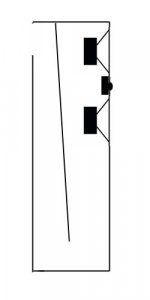BillFitzmaurice said:The definitive work to date on TLs was published by George Augsperger in Speaker Builder magazine in issues 2, 3 & 4 of 2000;
Bill, the use of "definitive" there is stretching it as it implies only, and that isn't the best version of his sole paper. George's articles are somewhat sketchy on practical and the best and most comprehensive one is the 3rd version that was published in the AES journal.
Augspurger cannot be mentioned without also mentioning Martin J King, who at the same time brought out his model (i was already talking to MJK about his model when i heard George's 1st presentation at the 1999 NY AES). Martin's work has been much more accessible than George's, Martin provides his worksheets for free download (althou you need to have a copy of mathCAD -- a free Explorer version can be downloaded), and MJKs work has had much more impact on the field, because many more people have used his software to explore TLs, and Martin has been around on the internet to share ideas, results, & to grow the sofistication of his modeling software.
MJK's mechanical analog & GA's electrical analog produce substantially the same results.
dave
planet10 said:
...Martin's work has been much more accessible than George's, Martin provides his worksheets for free download (althou you need to have a copy of mathCAD -- a free Explorer version can be downloaded)...
I downloaded all of Mr. King's worksheets and the free version of MathCad 8. And have begun to model TLs for the Peerless woofers...pretty cool stuff! The world needs more people like Mr. King, offering all his hard work for free so others can utilize it for there own projects.
All so I like to "give a shout out" to BillFitzmaurice and Plant10 for all their help in this tread!
I've decided to not make a subwoofer (if it can really be called that) in favor of a floor standing MTM using the same woofers along with a pair of Dynaudio D28/2 tweeters I have. It will be a poor man's Thor. When I realized to "sub" would be too large and wouldn't give the kind of extension a true subwoofer would have I started thinking....
I could get two more woofers for less then the cost of the plate amplifier and with four woofers in the room the bass response would probably have more impact (feel). Also I get to use my Dyn's. I know there are better tweeters out there but for what I can afford I doubt they could be beat.
I look forward to building them this up coming spring. My Step Dad's brother is quite the woodworker (huge fully equipted workshop) and hope he can help me with their construction.
Thanks again!
Attachments
There is a basic difference between Martin's calcs and Augsperger's, as Augsperger addresses the design aspects of a pure 1/4 wave non-resonant system while Martin combines aspects of both 1/4 wave and reflex alignments. Martin also relies far less on the T/S drivers parameters in predicting response, placing more emphasis on the box than the driver. I couldn't say that one approach is better than the other per se, but Martin's MLTLs are, as the name implies, mass-loaded, and TLs designed according to Augsperger's methods are not.
Going with a Thor clone makes more sense than a pure sub as far as a TL is concerned, as your line is the same length but in a floorstander you're getting a full-range box rather than a very large sub that still would require an additional midbass box to complete the system. I'd say that if you duplicate the Thor dimensions with your drivers that you'll end up with a very nice result.
Going with a Thor clone makes more sense than a pure sub as far as a TL is concerned, as your line is the same length but in a floorstander you're getting a full-range box rather than a very large sub that still would require an additional midbass box to complete the system. I'd say that if you duplicate the Thor dimensions with your drivers that you'll end up with a very nice result.
BillFitzmaurice said:There is a basic difference between Martin's calcs and Augsperger's, as Augsperger addresses the design aspects of a pure 1/4 wave non-resonant system while Martin combines aspects of both 1/4 wave and reflex alignments. Martin also relies far less on the T/S drivers parameters in predicting response, placing more emphasis on the box than the driver. I couldn't say that one approach is better than the other per se, but Martin's MLTLs are, as the name implies, mass-loaded, and TLs designed according to Augsperger's methods are not.
Huh???
I haven't seen Augspurger's SW but he clearly addresses the restricted terminus (ie mass-loading), that covers the bass reflex aspect you mention and it is a bit of a pain that Martin uses some more obscure parameters instead of Vas, but i believe it is possible to derive the Vas from the parameters MJK uses.
The important thing is that with the same input both generate substantially similar results.
dave
- Status
- This old topic is closed. If you want to reopen this topic, contact a moderator using the "Report Post" button.
